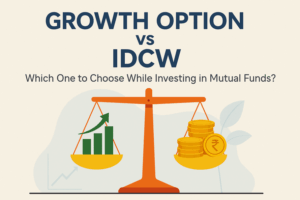SIP Calculator
×
Open Ended vs. Close Ended Mutual Funds: Understanding the differences

Direct investing in stocks is not for everyone, as it involves risks and requires a thorough understanding of how financial markets function. Mutual funds have emerged as the preferred investment vehicle for risk-averse retail investors in India due to their professional fund management and easy availability.
Open-ended and closed-ended funds are two primary mutual fund categories catering to varying investor needs and preferences. Understanding the differences between open-ended and closed-ended mutual funds is essential to make informed investment decisions.
In this article, we will learn what open-ended and closed-ended mutual funds are, their features, and their differences. This will help you decide which type aligns best with your financial goals.
What is an open-ended mutual fund?
Mutual funds are a type of collective investment. An open-ended mutual fund scheme allows investors to buy and sell mutual fund units anytime. All buy-and-sell transactions in open-ended mutual funds are based on the Net Asset Value (NAV).
Open-ended mutual funds pool money from multiple investors to create a diversified portfolio of securities, such as stocks, bonds, or a combination of both. The NAV is calculated daily, reflecting the market value of the fund’s underlying assets.
These funds allow investors to buy and sell anytime, making open-ended mutual funds highly liquid and flexible, providing them access to their money as needed.
Advantages of Open-Ended Mutual Funds
- Liquidity:
Open-ended mutual funds are highly liquid as investors can redeem their units anytime, making them ideal for those who need quick access to their money.
- Diversification:
Open-ended mutual funds provide diversification by investing in various assets such as equity, fixed-income securities, and government debt. Diversification helps reduce concentration risk.
- Professional Management:
Mutual funds are pooled investments. The pooled money is handled and invested by seasoned professional fund managers. Professional managers optimize returns while balancing risk.
- Convenience:
Open-ended mutual funds offer redemption flexibility and investment flexibility. SIPs (Systematic Investment Plans) and lump-sum investments are the two ways of investing in open-ended mutual funds. Investors can pause or stop their SIPs at any time.
While open-ended mutual funds are preferred by investors for benefits such as diversification, redemption flexibility, and professional management, the funds do have some disadvantages. As an investor, it is essential to understand the downsides to evaluate open-ended mutual fund schemes thoroughly.
“Start investing with confidence! Explore the best
mutual funds
and grow your wealth.”
Disadvantages of Open-Ended Mutual Funds
- Market Risk:
Open-ended mutual funds investing in the equity market are susceptible to market fluctuations, which can impact the value of investments.
- Fees:
Professional management of mutual funds has costs—expense ratios and management fees. Higher expense ratios and management fees can reduce overall portfolio returns.
- Overtrading:
This is true for actively traded open-ended mutual funds. Fund managers frequently buy and sell securities, increasing transaction costs that hurt overall returns.
What are close-ended mutual funds?
As the name indicates, close-ended mutual funds are closed schemes launched with a fixed number of units during the New Fund Offering (NFO). Once the NFO closes, no new units will be issued for the same fund.
Market regulator SEBI has mandated all close-ended mutual funds to be listed on stock exchanges. Thus, once the NFO closes, the units will trade on exchanges like the NSE or the BSE, just like stocks.
Closed-ended funds typically have a fixed tenure and are dissolved at maturity, with investors receiving the prevailing NAV. This structured approach to investment provides fund managers with stable capital for long-term strategies, as they do not have to worry about frequent redemptions.
Key Advantages of Closed-Ended Mutual Funds:
- Fixed Term:
These funds have a predetermined lifespan. The lifespan of the scheme will be mentioned during the NFO. The fixed term offers stability for fund managers to execute their strategies.
- Secondary Market Trading:
SEBI mandates listing the close-ended scheme units on exchanges to offer liquidity to investors during the scheme tenure. This allows investors to buy or sell at market prices, just like stocks. However, the market price is impacted by demand and supply economics and thus may differ from the NAV.
- Stability of Assets Under Management (AUM):
The fixed capital base allows for more consistent investment strategies without the pressure of redemptions.
Disadvantages of Close-Ended Mutual Funds
While close-ended funds are suited for long-term holding and disciplined investments, they have the following disadvantages:
- Limited Liquidity:
Close-ended schemes do not allow investors to redeem units until maturity. While the units are listed on exchanges, they might trade below the NAV if demand is low. This limits the liquidity offered by close-ended schemes.
- Lumpsum Investment:
SIPs are not possible in close-ended schemes, as all investments must be made during the NFO. This means investors need to make a significant upfront investment which may not be suitable for all investors.
- No Prior Performance Record:
Open-ended mutual funds have past performance records, making it easy for investors to evaluate the scheme. Since all investments in a close-ended scheme happen during the NFO, there is no past performance record of the scheme. This makes investment decision-making difficult.
Differences between open-ended and close-ended mutual funds
The primary differences between open-ended and closed-ended mutual funds lie in their structure, liquidity, investment flexibility, and risk profile. Here are the key differences at a glance:
| Feature | Open-Ended Mutual Funds | Closed-Ended Mutual Funds |
| Liquidity | Highly liquid; can buy/sell units at any time based on NAV | Limited liquidity; units traded on stock exchanges or redeemed at maturity |
| Investment Flexibility | Allows SIPs and lump-sum investments at any time | Investments are restricted to the NFO period; no SIPs are available |
| Risk Profile | Subject to market fluctuations; frequent redemptions can impact performance. | Less susceptible to redemption pressures; market risk still applies |
| Minimum Investment | Lower minimum investment requirements | Requires a higher initial investment |
| Management Style | Requires active management due to continuous inflows/outflows | Offers stable capital for long-term strategies |
Open-Ended vs. Close-Ended Mutual Fund: Which one should you choose?
The investment choice between open-ended and close-ended funds will depend on the investor’s goals, investment horizon, risk tolerance, and liquidity needs.
- Open-ended funds are ideal for:
- Investors seeking liquidity and flexibility in their investments.
- Those who prefer to invest through SIPs or make frequent adjustments to their portfolio.
- Individuals with a shorter investment horizon or who may need quick access to their funds.
- Closed-Ended Funds are suitable for:
- Long-term investors who can commit to holding their investments until maturity.
- Those who prefer a disciplined investment approach and not inclined to withdraw prematurely.
- Investors who are comfortable with trading on secondary markets if they need to exit before maturity.
Conclusion
Open-ended and closed-ended mutual funds have unique advantages and downsides, catering to different investor profiles. Open-ended funds provide liquidity and flexibility, making them suitable for investors who need quick access to their funds or prefer dynamic portfolio adjustments. On the other hand, closed-ended funds offer stability and a disciplined investment approach, ideal for long-term investors who can hold their investments until maturity.
Choosing between these two types of funds should be based on your financial goals, risk tolerance, and investment horizon. Understanding the characteristics of each can help you make informed decisions and optimize your investment strategy. Whether you prioritize liquidity and flexibility or stability and long-term growth, there is a mutual fund category that aligns with your needs and helps you achieve your financial objectives.
Disclaimer
The stocks mentioned in this article are not recommendations. Please conduct your own research and due diligence before investing. Investment in securities market are subject to market risks, read all the related documents carefully before investing. Please read the Risk Disclosure documents carefully before investing in Equity Shares, Derivatives, Mutual fund, and/or other instruments traded on the Stock Exchanges. As investments are subject to market risks and price fluctuation risk, there is no assurance or guarantee that the investment objectives shall be achieved. Lemonn (Formerly known as NU Investors Technologies Pvt. Ltd) do not guarantee any assured returns on any investments. Past performance of securities/instruments is not indicative of their future performance.







